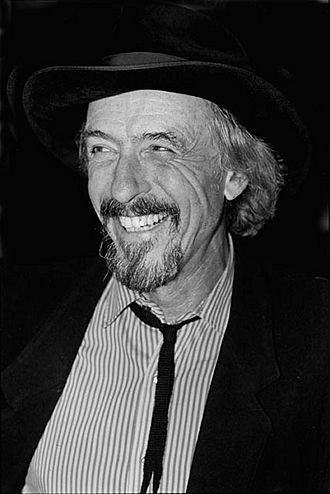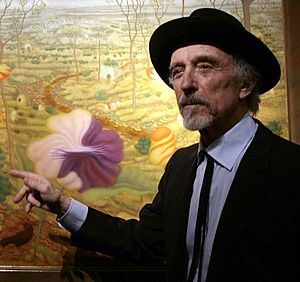Arik Brauer facts for kids
Quick facts for kids
Arik Brauer
|
|
|---|---|

Arik Brauer at the Galerie Latal in Zürich in 1991
|
|
| Born |
Erich Brauer
4 January 1929 |
| Died | 24 January 2021 (aged 92) Vienna, Austria
|
| Education | Academy of Fine Arts Vienna |
| Occupation |
|
| Organization |
|
| Known for |
|
| Spouse(s) |
Naomi Dahabani
(m. 1957) |
| Children | 3 |
| Awards |
|
Arik Brauer (Hebrew: אריק בראואר; 4 January 1929 – 24 January 2021) was a famous Austrian artist. He was a painter, printmaker, poet, dancer, singer-songwriter, stage designer, and architect. He also taught at a university.
Brauer came from a family of Jewish people who moved to Austria. He grew up in Vienna when the Nazis were in power. After World War II, he started studying art at the Academy of Fine Arts Vienna when he was 16. He also studied singing.
He traveled a lot and got married in Israel in 1957. He lived in Paris for a while, where he sang with his wife. Later, they lived in Ein Hod, Israel, and in Vienna. Arik Brauer helped start the Vienna School of Fantastic Realism, a special art style.
People in Austria called him an Universalkünstler, meaning an "all-round artist." In the 1970s, he became a popular singer-songwriter, helping to create Austropop music. From 1985, he taught at the Academy of Fine Arts Vienna. In the 1990s, he designed buildings in Austria and Israel.
His art was shown in galleries and museums around the world. He received many awards, including the Austrian Cross of Honour for Science and Art in 2002. He also won the Amadeus Austrian Music Awards for his life's work in music in 2015.
Contents
Arik Brauer's Early Life and Art Journey
Erich Brauer was born in Vienna. His parents were Jewish people who had moved from Lithuania. His father was a craftsman. Arik remembered growing up in a small apartment.
As a child, he loved to draw. He drew scenes from the streets, nature, and characters from books. A fellow artist, Ernst Fuchs, said Brauer was a "mystic" who loved nature. Before becoming an artist, Brauer worked as a carpenter's helper.
Brauer survived World War II by hiding in a garden area. Sadly, his father died during the Nazi era. After the war, Brauer joined a youth group. He helped with cultural activities, like leading a choir and drawing for a newspaper. He soon realized his main passion was art, not politics.
Studying Art and Music
In 1945, Brauer began studying at the Academy of Fine Arts Vienna. He learned from famous teachers like Albert Paris von Gütersloh. From 1947 to 1951, he also studied singing. In 1949, he visited Paris for the first time. A year later, he rode his bike through North Africa.
Brauer officially finished his studies in 1954. He then worked as a singer and dancer in Israel. In 1956, he danced at the Raimund Theater in Vienna.
Fantastic Realism and Early Works
His teacher, Gütersloh, helped Brauer's art become known. Brauer joined a group of artists who formed the Vienna School of Fantastic Realism in the mid-1950s. This group included artists like Ernst Fuchs and Rudolf Hausner.
Even though abstract art was popular then, Brauer's art stood out. He combined great skill with surrealism, which is art that looks like dreams. This made him famous around the world. Some of his early works include Vogelfang (Bird Catch) from 1962, which shows mythical creatures. Another is Der Regenmacher vom Karmel (The Rainmaker from Carmel) from 1964, a colorful paradise scene. From 1963 to 1965, there was a traveling exhibition of the Vienna School of Fantastic Realism.
Arik Brauer's Diverse Career
After his studies, Brauer traveled widely. In 1957, he married Naomi Dahabani in Israel. They moved to Paris in 1958 and became singers, performing as "Neomi et Arik Bar-Or." They returned to Vienna in 1964.
Music and Stage Design
In the 1970s, Brauer focused on singing. He wrote and performed songs in Austrian dialect. Songs like "Sie ham a Haus baut" (They built a house) became popular. These songs were important early examples of Austropop, which is pop music in Austrian dialect.
His 1971 album, Arik Bauer, sold very well and earned two Gold records. Some of his songs became like traditional folk songs, sung in gatherings. In 1975, Brauer designed the stage and costumes for Mozart's opera Die Zauberflöte at the Paris Opera.
Teaching and Architecture
In 1982, Brauer had successful art shows in the United States. He also gave many talks at American universities. From 1985 to 1997, he taught at the Vienna Academy.
In the 1990s, Brauer started designing buildings. He worked on projects in Austria and Israel. His buildings often have amazing mosaics, murals, and painted tiles on their outside and inside. He designed the Arik-Brauer-Haus in Vienna, finished in 1993. He also designed the Voitsberg town hall and a shopping mall in Haifa, Israel. The mall's facade has his huge mural called Adam and Eve in the Garden of Eden. In 2002, he designed the United Buddy Bear for Austria.
Later Life and Exhibitions
For his 70th birthday, a museum in Vienna showed works from Brauer's own collection. This included his series The persecution of the Jewish people, which he started in 1973. It also showed his etchings about human rights, and designs for The Magic Flute. He even created a children's book and a TV play with his daughter, Timna.
In 2015, a large exhibition of his art, "Arik Brauer – Bilder des Phantastischen Realisten," was held at the Leopold Museum.
From 1963, Brauer and his wife spent several months each summer in Israel. They lived in an artist community that he designed. One of their three daughters, Timna, is a jazz singer. For his 90th birthday, his daughter Ruth Brauer-Kvam wrote a play about his life. He designed the stage for it.
Arik Brauer passed away in Vienna on January 24, 2021, at the age of 92.
Exhibitions
Here are some of the places where Arik Brauer's art was shown:
- "Die Hundsgruppe" — his first group show, Vienna 1951
- Galerie Raymond Cordier, Paris 1961
- Galerie Flinker, Paris 1964
- Museum des 20. Jahrhunderts, Vienna 1970
- Marlborough Galerie, Zürich, 1973
- Albertina, Vienna 1974 (a show of his graphic works)
- Österreichische Galerie Belvedere, Vienna 1976
- Jewish Museum, New York 1978
- A traveling exhibition around the world from 1979 to 1983
- Jack Rutberg Fine Arts, Los Angeles 1989
- KunstHausWien, Vienna 2003–2004
- Jewish Museum Vienna, 2014 (showing his illustrations for the Haggadah)
- Leopold Museum, Vienna 2014–2015 (a big show of all his art)
- Jewish Museum Vienna, 2019 (an exhibition called All of My Arts for his 90th birthday)
Writings
Arik Brauer also wrote books:
- Arik Brauer: Das Runde fliegt: Texte, Lieder, Bilder (Munich, 1983) - This book includes his texts, songs, and pictures.
- Arik Brauer: Werkverzeichnis, 3 vols (Dortmund, 1984) - This is a list of all his artworks.
Awards
Arik Brauer received many important awards for his work:
- City of Vienna Prize for Visual Arts (1979)
- Golden Medal of Honour for Services to the City of Vienna (1989)
- Austrian Cross of Honour for Science and Art, (1st class) (2002)
- Decoration of Honor for Services to the State of Vienna (2011)
- Amadeus Austrian Music Awards, Lifetime Achievement (2015) - This was for his amazing career in music.
- Decoration of Honour for Services to the Republic of Austria, Grand Decoration of Honour in Gold (2018)
- Fritz Csoklich Prize (2019)
See also
 In Spanish: Arik Brauer para niños
In Spanish: Arik Brauer para niños



